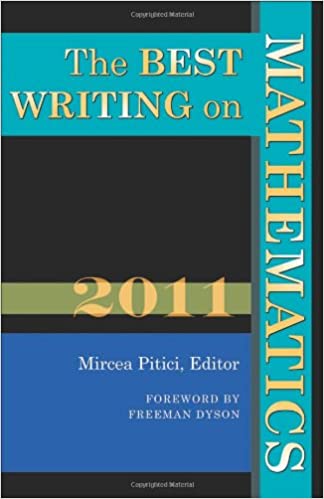The Best Writing on Mathematics 2011 and 2012

 The Best Writing on Mathematics 2011
The Best Writing on Mathematics 2011
Paperback, 383 pages,
Published November 7, 2011
Princeton University Press,
ISBN: 0691153159.
The Best Writing on Mathematics 2012
Paperback, 288 pages,
Published October 22, 2012
Princeton University Press,
ISBN: 0691156557.
These two volumes of anthology bring together from around the world the finest mathematics writing in the years 2011 and 2012. Featuring promising new voices alongside some of the foremost names in the field, “The Best Writing on Mathematics 2011” and “The Best Writing on Mathematics 2012” make available to a wide audience many articles not easily found anywhere else— and you don’t need to be a mathematician to enjoy them. These writings offer surprising insights into the nature, meaning, and practice of mathematics today. They delve into the history, philosophy, teaching, and everyday occurrences of math, and take readers behind the scenes of today’s hottest mathematical debates.
 In “The Best Writing on Mathematics 2011”, Ian Hacking discusses the salient features that distinguish mathematics from other disciplines of the mind; Doris Schattschneider identifies some of the mathematical inspirations of M C Escher’s art; Jordan Ellenberg describes compressed sensing, a mathematical field that is reshaping the way people use large sets of data; Erica Klarreich reports on the use of algorithms in the job market for doctors; and much, much more. In addition to presenting the year’s most memorable writings on mathematics, this must-have anthology includes a foreword by esteemed physicist and mathematician Freeman Dyson.
In “The Best Writing on Mathematics 2011”, Ian Hacking discusses the salient features that distinguish mathematics from other disciplines of the mind; Doris Schattschneider identifies some of the mathematical inspirations of M C Escher’s art; Jordan Ellenberg describes compressed sensing, a mathematical field that is reshaping the way people use large sets of data; Erica Klarreich reports on the use of algorithms in the job market for doctors; and much, much more. In addition to presenting the year’s most memorable writings on mathematics, this must-have anthology includes a foreword by esteemed physicist and mathematician Freeman Dyson.
In “The Best Writing on Mathematics 2012”, Robert Lang explains mathematical aspects of origami foldings; Terence Tao discusses the frequency and distribution of the prime numbers; Timothy Gowers and Mario Livio ponder whether mathematics is invented or discovered; Brian Hayes describes what is special about a ball in five dimensions; Mark Colyvan glosses on the mathematics of dating; and much, much more.
These two books belong on the shelf of anyone interested in where math has taken us— and where it is headed.
Mircea Pitici
Editor, Asia Pacific Mathematics Newsletter.
Source:- Asia Pacific Mathematics Newsletter, Volume 3 No. 2 (April 2013).
It has been republished here with a special permission from World Scientific.